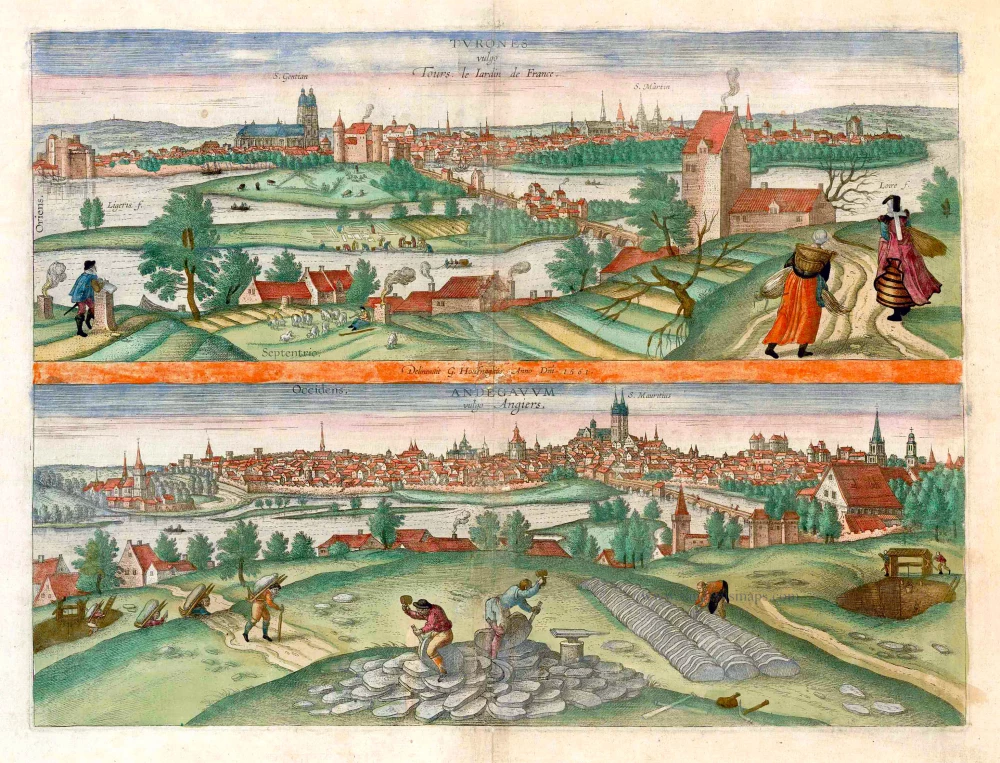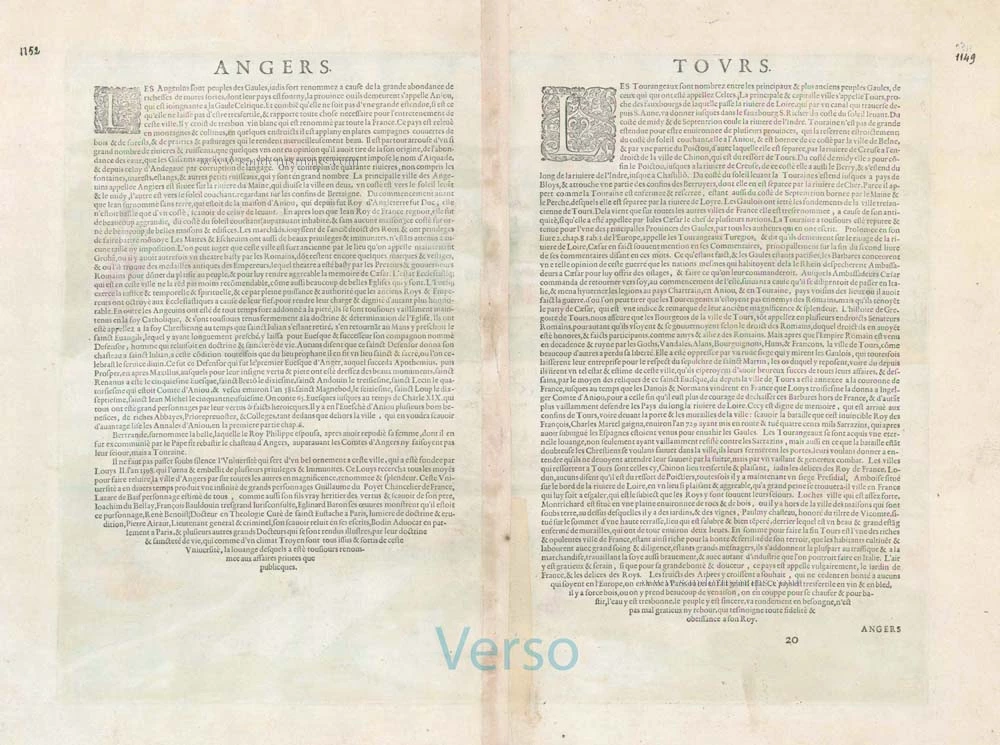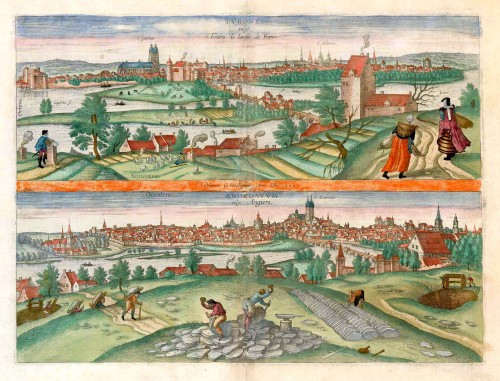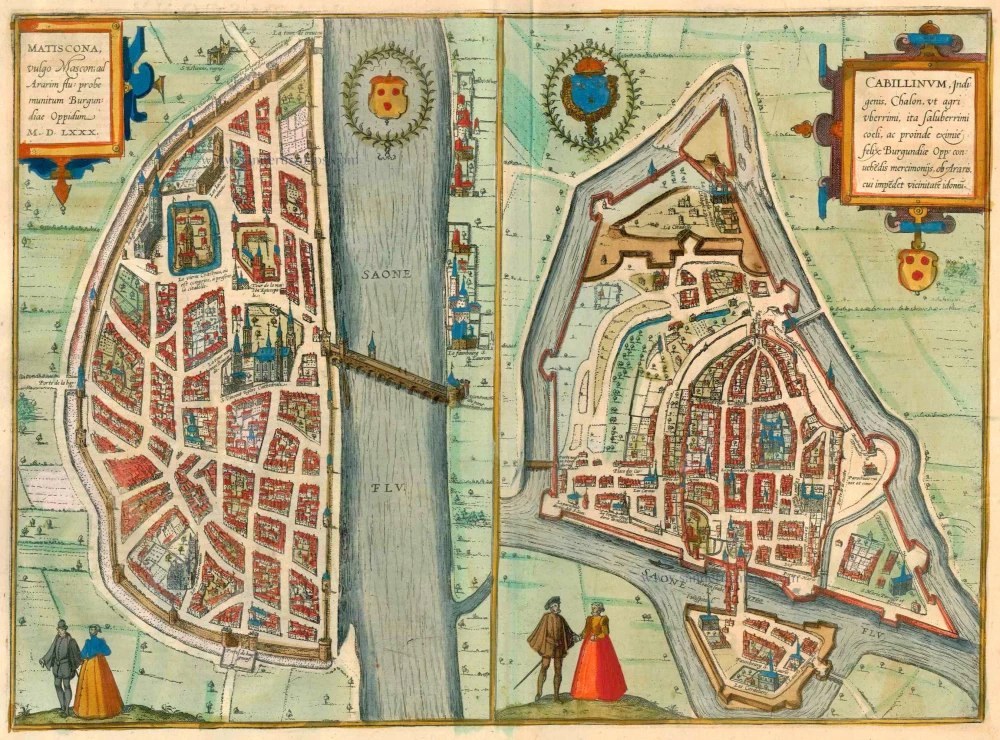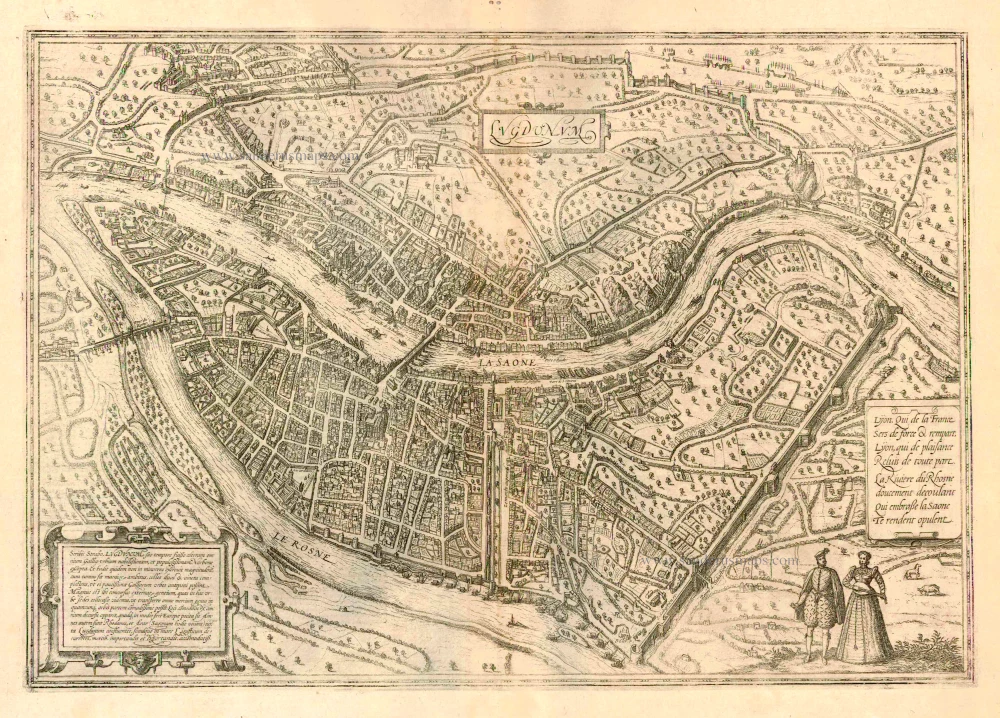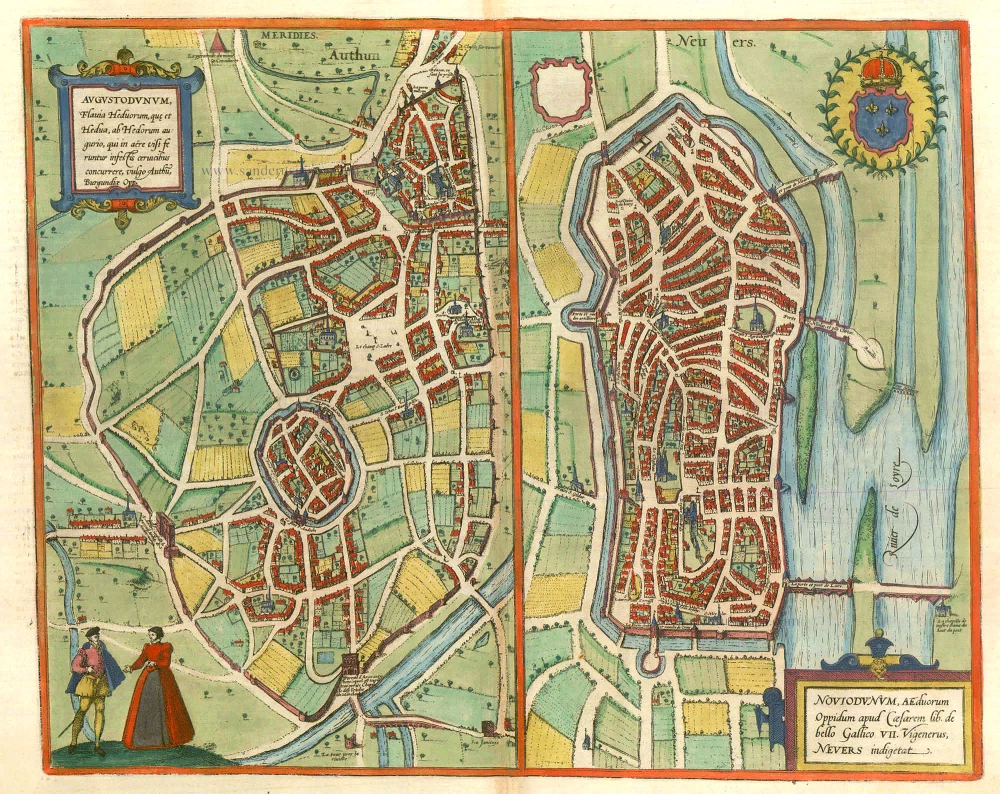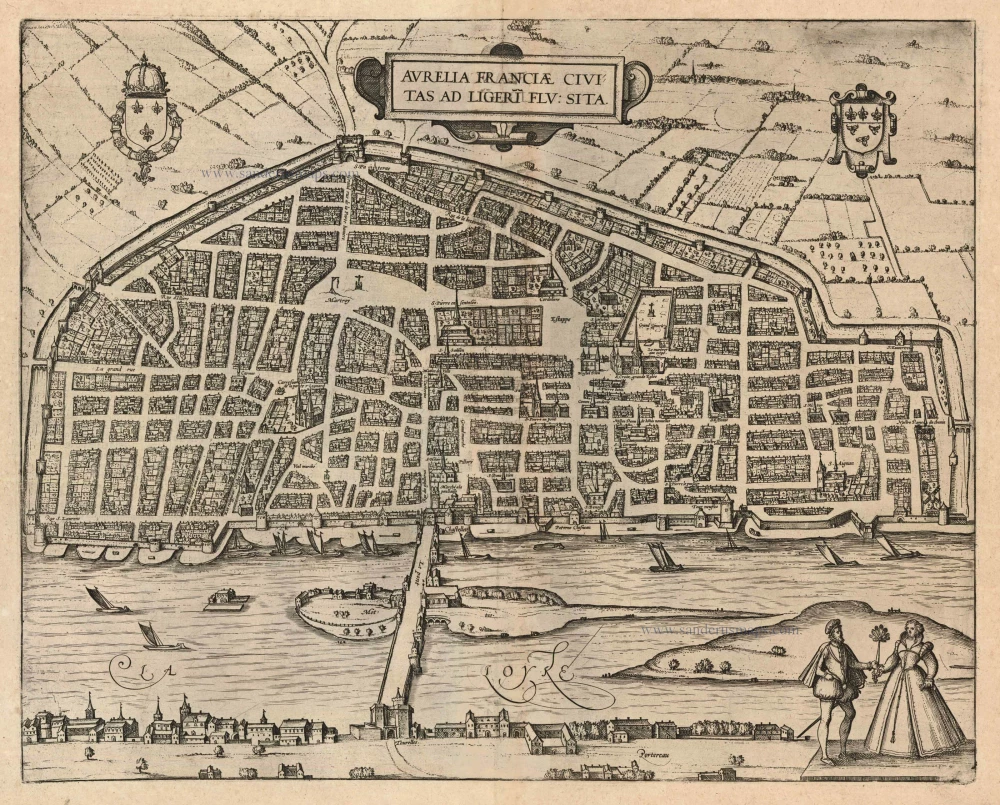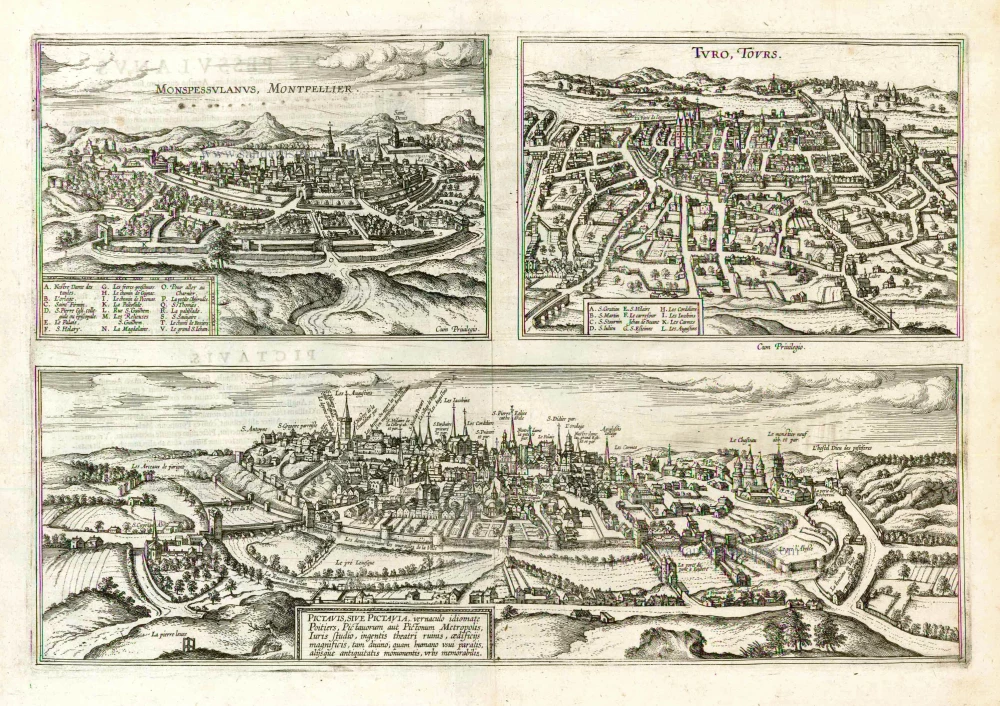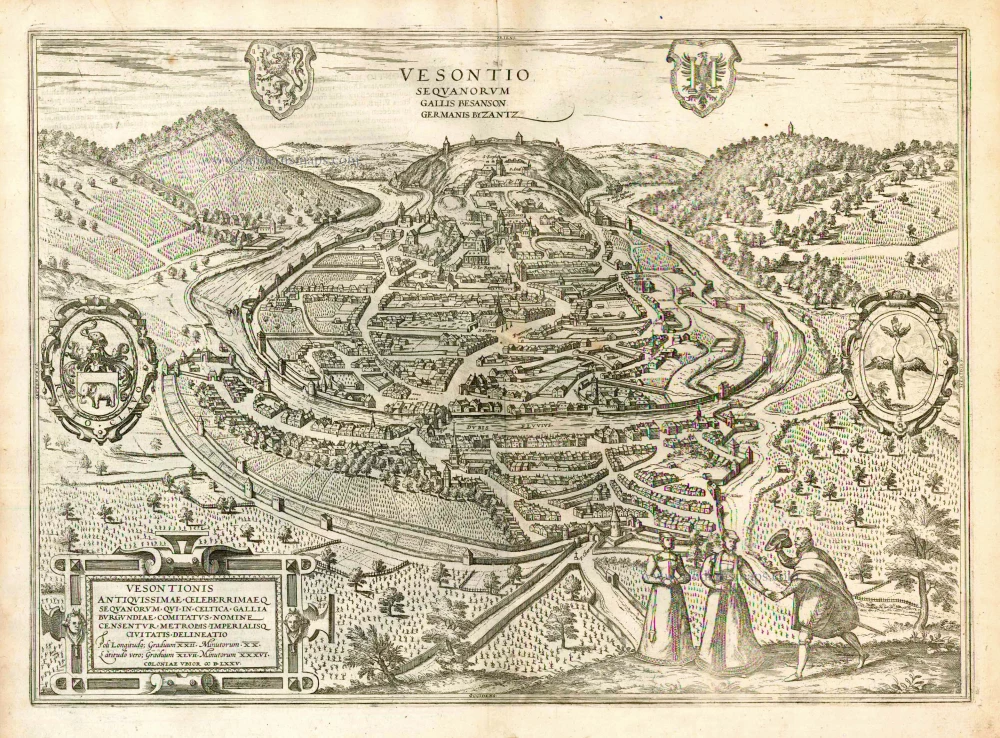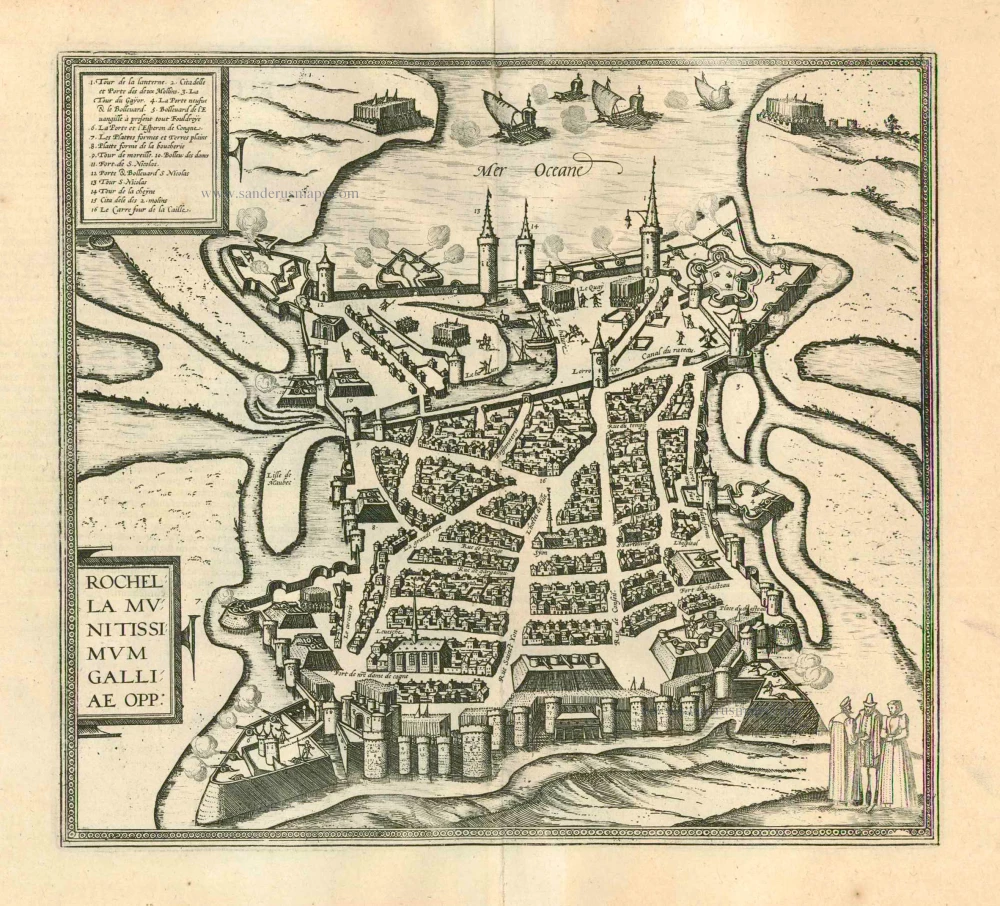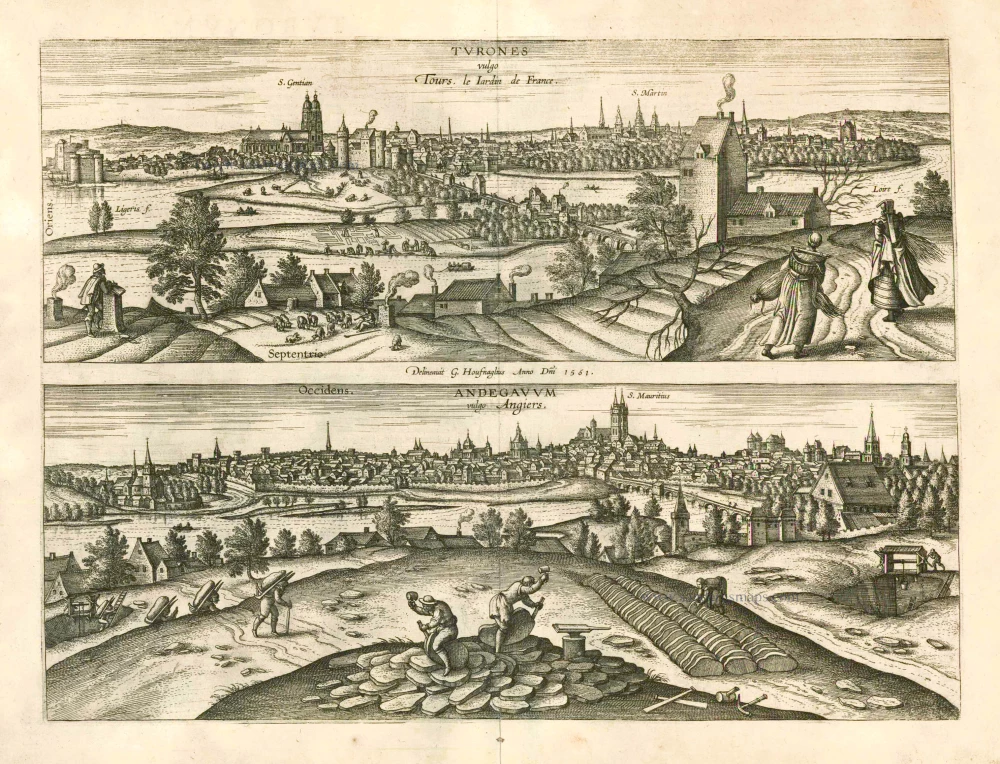Tours and Angers, by Georg Braun and Frans Hogenberg. c. 1610
TOURS
CAPTION: Turones, in the vernacular Tours, the garden of France.
COMMENTARY BY BRAUN: "The Touronians are the most ancient and noble of all the other peoples of France [...] Tours is also one of France's richest cities, whose wealth is founded on its fertile arable land, they also conduct lively trade and manufacture excellent cloth, as soft and handsome as if it had been made in Italy."
In this second engraving of Tours, the city is seen from the opposite direction, i.e. from the north looking across the Loire and the Island of Aucard. Rising in front of the Gothic cathedral of Saint-Gatien in the left half of the picture is the château of the kings of France, including the Tour de Guise that still stands today. On the far right is Notre-Dame-la-Riche. The draughtsman has depicted himself at work in the left-hand foreground.
ANGERS
CAPTION: Andegavum, in the vernacular Angers.
COMMENTARY BY BRAUN: "The city of Angers lies on the Maine, which divides it into two halves, so that one part lies to the southeast and the other towards the west. The local merchants have the right to mint their coins."
Angers, the former capital of Anjou, is seen from the west. Far left lies the Benedictine abbey of Saint-Serge. The cathedral of Saint-Maurice can be seen in the centre and, beside it, the episcopal palace. In front of the cathedral on the left rises the massive tower of Saint-Aubin abbey. Today, all that remains of the former monastery complex, whose other buildings have since been converted for public use, is the Prefecture and a banquet hall. To the cathedral's right lies the Château d'Angers, a fortress surrounded by a wall with 17 towers. The staffage figures in the foreground refer to a distinctive feature of the area around Angers: the quarrying of slate. (Taschen)
Both engravings are made after drawings by Georg Hoefnagel.
Braun G. & Hogenberg F. and the Civitates Orbis Terrarum.
The Civitates Orbis Terrarum, also known as the 'Braun & Hogenberg', is a six-volume town atlas and the most excellent book of town views and plans ever published: 363 engravings, sometimes beautifully coloured. It was one of the best-selling works in the last quarter of the 16th century. Georg Braun, a skilled writer, wrote the text accompanying the plans and views on the verso. Many plates were engraved after the original drawings of a professional artist, Joris Hoefnagel (1542-1600). The first volume was published in Latin in 1572 and the sixth in 1617. Frans Hogenberg, a talented engraver, created the tables for volumes I through IV, and Simon van den Neuwel made those for volumes V and VI. Other contributors were cartographers Daniel Freese and Heinrich Rantzau, who provided valuable geographical information. Works by Jacob van Deventer, Sebastian Münster, and Johannes Stumpf were also used as references. Translations appeared in German and French, making the atlas accessible to a broader audience.
Since its original publication of volume 1 in 1572, the Civitates Orbis Terrarum has left an indelible mark on the history of cartography. Seven more editions followed the first volume in 1575, 1577, 1582, 1588, 1593, 1599, and 1612. Vol.2, initially released in 1575, saw subsequent editions in 1597 and 1612. The subsequent volumes, each a treasure trove of historical insights, graced the world in 1581, 1588, 1593, 1599, and 1606. The German translation of the first volume, a testament to its widespread appeal, debuted in 1574, followed by the French edition in 1575.
Several printers were involved: Theodor Graminaeus, Heinrich von Aich, Gottfried von Kempen, Johannis Sinniger, Bertram Buchholtz, and Peter von Brachel, all of whom worked in Cologne.
Georg Braun (1541-1622)
Georg Braun, the author of the text accompanying the plans and views in the Civitates Orbis Terrarum, was born in Cologne in 1541. After his studies in Cologne, he entered the Jesuit Order as a novice, indicating his commitment to learning and intellectual pursuits. In 1561, he obtained his bachelor's degree; in 1562, he received his Magister Artium, further demonstrating his academic achievements. Although he left the Jesuit Order, he continued his studies in theology, gaining a licentiate in theology. His theological background likely influenced the content and tone of the text in the Civitates Orbis Terrarum, adding a unique perspective to the work.
Frans Hogenberg (1535-1590)
Frans Hogenberg was a Flemish and German painter, engraver, and mapmaker. He was born in Mechelen as the son of Nicolaas Hogenberg.
By the end of the 1560s, Frans Hogenberg was employed upon Abraham Ortelius's Theatrum Orbis Terrarum, published in 1570; he is named an engraver of numerous maps. In 1568, he was banned from Antwerp by the Duke of Alva and travelled to London, where he stayed a few years before emigrating to Cologne. He immediately embarked on his two most important works, the Civitates, published in 1572 and the Geschichtsblätter, which appeared in several series from 1569 until about 1587.
Thanks to large-scale projects like the Geschichtsblätter and the Civitates, Hogenberg's social circumstances improved with each passing year. He died as a wealthy man in Cologne in 1590.
Turones vulgo Tours, le Iardin de France. [on sheet with:] Andegavum vulgo Angiers.
Item Number: 25956 Authenticity Guarantee
Category: Antique maps > Europe > France - Cities
Old, antique map with two bird's-eye views by Braun and Hogenberg: Tours and Angers.
Carte ancienne avec deux vues à vol d'oiseau: Tours et Angers.
Date of the first edition: 1596
Date of this map: c. 1610
Copper engraving, printed on paper.
Size (not including margins): 34.5 x 46cm (13.5 x 17.9 inches)
Verso text: French
Condition: Original coloured, centrefold repaired.
Condition Rating: B
References: Van der Krogt 4, 4456; Fauser, #14138 & #457; Taschen, Braun and Hogenberg, p.371.
From: Théâtre des Principales Villes de tout l'Univers. Tome 5. c. 1610.
TOURS
CAPTION: Turones, in the vernacular Tours, the garden of France.
COMMENTARY BY BRAUN: "The Touronians are the most ancient and noble of all the other peoples of France [...] Tours is also one of France's richest cities, whose wealth is founded on its fertile arable land, they also conduct lively trade and manufacture excellent cloth, as soft and handsome as if it had been made in Italy."
In this second engraving of Tours, the city is seen from the opposite direction, i.e. from the north looking across the Loire and the Island of Aucard. Rising in front of the Gothic cathedral of Saint-Gatien in the left half of the picture is the château of the kings of France, including the Tour de Guise that still stands today. On the far right is Notre-Dame-la-Riche. The draughtsman has depicted himself at work in the left-hand foreground.
ANGERS
CAPTION: Andegavum, in the vernacular Angers.
COMMENTARY BY BRAUN: "The city of Angers lies on the Maine, which divides it into two halves, so that one part lies to the southeast and the other towards the west. The local merchants have the right to mint their coins."
Angers, the former capital of Anjou, is seen from the west. Far left lies the Benedictine abbey of Saint-Serge. The cathedral of Saint-Maurice can be seen in the centre and, beside it, the episcopal palace. In front of the cathedral on the left rises the massive tower of Saint-Aubin abbey. Today, all that remains of the former monastery complex, whose other buildings have since been converted for public use, is the Prefecture and a banquet hall. To the cathedral's right lies the Château d'Angers, a fortress surrounded by a wall with 17 towers. The staffage figures in the foreground refer to a distinctive feature of the area around Angers: the quarrying of slate. (Taschen)
Both engravings are made after drawings by Georg Hoefnagel.
Braun G. & Hogenberg F. and the Civitates Orbis Terrarum.
The Civitates Orbis Terrarum, also known as the 'Braun & Hogenberg', is a six-volume town atlas and the most excellent book of town views and plans ever published: 363 engravings, sometimes beautifully coloured. It was one of the best-selling works in the last quarter of the 16th century. Georg Braun, a skilled writer, wrote the text accompanying the plans and views on the verso. Many plates were engraved after the original drawings of a professional artist, Joris Hoefnagel (1542-1600). The first volume was published in Latin in 1572 and the sixth in 1617. Frans Hogenberg, a talented engraver, created the tables for volumes I through IV, and Simon van den Neuwel made those for volumes V and VI. Other contributors were cartographers Daniel Freese and Heinrich Rantzau, who provided valuable geographical information. Works by Jacob van Deventer, Sebastian Münster, and Johannes Stumpf were also used as references. Translations appeared in German and French, making the atlas accessible to a broader audience.
Since its original publication of volume 1 in 1572, the Civitates Orbis Terrarum has left an indelible mark on the history of cartography. Seven more editions followed the first volume in 1575, 1577, 1582, 1588, 1593, 1599, and 1612. Vol.2, initially released in 1575, saw subsequent editions in 1597 and 1612. The subsequent volumes, each a treasure trove of historical insights, graced the world in 1581, 1588, 1593, 1599, and 1606. The German translation of the first volume, a testament to its widespread appeal, debuted in 1574, followed by the French edition in 1575.
Several printers were involved: Theodor Graminaeus, Heinrich von Aich, Gottfried von Kempen, Johannis Sinniger, Bertram Buchholtz, and Peter von Brachel, all of whom worked in Cologne.
Georg Braun (1541-1622)
Georg Braun, the author of the text accompanying the plans and views in the Civitates Orbis Terrarum, was born in Cologne in 1541. After his studies in Cologne, he entered the Jesuit Order as a novice, indicating his commitment to learning and intellectual pursuits. In 1561, he obtained his bachelor's degree; in 1562, he received his Magister Artium, further demonstrating his academic achievements. Although he left the Jesuit Order, he continued his studies in theology, gaining a licentiate in theology. His theological background likely influenced the content and tone of the text in the Civitates Orbis Terrarum, adding a unique perspective to the work.
Frans Hogenberg (1535-1590)
Frans Hogenberg was a Flemish and German painter, engraver, and mapmaker. He was born in Mechelen as the son of Nicolaas Hogenberg.
By the end of the 1560s, Frans Hogenberg was employed upon Abraham Ortelius's Theatrum Orbis Terrarum, published in 1570; he is named an engraver of numerous maps. In 1568, he was banned from Antwerp by the Duke of Alva and travelled to London, where he stayed a few years before emigrating to Cologne. He immediately embarked on his two most important works, the Civitates, published in 1572 and the Geschichtsblätter, which appeared in several series from 1569 until about 1587.
Thanks to large-scale projects like the Geschichtsblätter and the Civitates, Hogenberg's social circumstances improved with each passing year. He died as a wealthy man in Cologne in 1590.

